Spatial Distribution of Global Cultivated Land and Its Variation between 2000 and 2010, from Both Agro-Ecological and Geopolitical Perspectives
Abstract
:1. Introduction
2. Materials and Methods
2.1. Land Cover Dataset
2.2. Cultivated Land Percentage
2.3. Rate of Land Use Change
3. Spatial Analysis and Results
3.1. Basic Spatial Analysis
3.2. Spatial Aggregation Analysis
3.2.1. Spatial Aggregation Analysis Based on 18 Agro-Ecological Zones
3.2.2. Spatial Aggregation Analysis Based on 32 Geopolitical and Socioeconomic Zones
3.2.3. Spatial Aggregation Analysis Based on 283 World Regions
4. Conclusions
Author Contributions
Funding
Acknowledgments
Conflicts of Interest
References
- FAO (Rome). How Does International Price Volatility Affect Domestic Economies and Food Security? Food and Agriculture Organization of the United Nations: Rome, Italy, 2011. [Google Scholar]
- Tilman, D. Global environmental impacts of agricultural expansion: The need for sustainable and efficient practices. Proc. Natl. Acad. Sci. USA 1999, 96, 5995–6000. [Google Scholar] [CrossRef] [PubMed]
- Godfray, H.C.J.; Beddington, J.R.; Crute, I.R.; Haddad, L.; Lawrence, D.; Muir, J.F.; Pretty, J.; Robinson, S.; Thomas, S.M.; Toulmin, C. Food security: The challenge of feeding 9 billion people. Science 2010, 327, 812–818. [Google Scholar] [CrossRef] [PubMed]
- Green, R.E.; Cornell, S.J.; Scharlemann, J.P.; Balmford, A. Farming and the fate of wild nature. Science 2005, 307, 550–555. [Google Scholar] [CrossRef] [PubMed]
- Burney, J.A.; Davis, S.J.; Lobell, D.B. Greenhouse gas mitigation by agricultural intensification. Proc. Natl. Acad. Sci. USA 2010, 107, 12052–12057. [Google Scholar] [CrossRef] [PubMed]
- Popp, A.; Lotze-Campen, H.; Bodirsky, B. Food consumption, diet shifts and associated non-CO2 greenhouse gases from agricultural production. Glob. Environ. Chang. 2010, 20, 451–462. [Google Scholar] [CrossRef]
- Zabel, F.; Putzenlechner, B.; Mauser, W. Global agricultural land resources–a high resolution suitability evaluation and its perspectives until 2100 under climate change conditions. PLoS ONE 2014, 9, e107522. [Google Scholar] [CrossRef] [PubMed]
- Bennetzen, E.H.; Smith, P.; Porter, J.R. Decoupling of greenhouse gas emissions from global agricultural production: 1970–2050. Glob. Chang. Biol. 2016, 22, 763–781. [Google Scholar] [CrossRef] [PubMed]
- Xie, H.; Zhang, Y.; Choi, Y. Measuring the Cultivated Land Use Efficiency of the Main Grain-Producing Areas in China under the Constraints of Carbon Emissions and Agricultural Nonpoint Source Pollution. Sustainability 2018, 10, 1932. [Google Scholar] [CrossRef]
- Ramankutty, N.; Achard, F.; Alves, D.; Turner, B., II; DeFries, R.; Goldewijk, K.; Graumlich, L.; Reid, R. Global changes in land cover. IHDP Update News. Int. Hum. Dimens. Program. Glob. Environ. Chang. 2005, 3, 4–5. [Google Scholar]
- Foley, J.A.; DeFries, R.; Asner, G.P.; Barford, C.; Bonan, G.; Carpenter, S.R.; Chapin, F.S.; Coe, M.T.; Daily, G.C.; Gibbs, H.K.; et al. Global consequences of land use. Science 2005, 309, 570–574. [Google Scholar] [CrossRef] [PubMed]
- Goldewijk, K.K.; Beusen, A.; Drecht, G.V.; Vos, M. The HYDE 3.1 spatially explicit database of human-induced global land-use change over the past 12,000 years. Glob. Ecol. Biogeogr. 2011, 20, 73–86. [Google Scholar] [CrossRef]
- Meneses, B.M.; Reis, E.; Pereira, S.; Vale, M.J.; Reis, R. Understanding driving forces and implications associated with the land use and land cover changes in Portugal. Sustainability 2017, 9, 351. [Google Scholar] [CrossRef]
- Jiménez, A.; Vilchez, F.; González, O.; Flores, S. Analysis of the Land Use and Cover Changes in the Metropolitan Area of Tepic-Xalisco (1973–2015) through Landsat Images. Sustainability 2018, 10, 1860. [Google Scholar] [CrossRef]
- Veldkamp, A.; Verburg, P.H. Modelling land use change and environmental impact. J. Environ. Manag. 2004, 72, 1–3. [Google Scholar] [CrossRef] [PubMed]
- Verburg, P.H.; Schot, P.P.; Dijst, M.J.; Veldkamp, A. Land use change modelling: Current practice and research priorities. GeoJournal 2004, 61, 309–324. [Google Scholar] [CrossRef]
- Salata, S. Land use change analysis in the urban region of Milan. Manag. Environ. Qual. Int. J. 2017, 28, 879–901. [Google Scholar] [CrossRef]
- Benini, L.; Bandini, V.; Marazza, D.; Contin, A. Assessment of land use changes through an indicator-based approach: A case study from the lamone river basin in Northern Italy. Ecol. Indic. 2010, 10, 4–14. [Google Scholar] [CrossRef]
- Bekunda, M.; Sanginga, N.; Woomer, P.L. Restoring soil fertility in sub-Sahara Africa. In Advances in Agronomy. Adv. Agron. 2010, 108, 183–236. [Google Scholar]
- Foley, J.A.; Ramankutty, N.; Brauman, K.A.; Cassidy, E.S.; Gerber, J.S.; Johnston, M.; Mueller, N.D.; Connell, C.O.; Ray, D.K.; West, P.C.; et al. Solutions for a cultivated planet. Nature 2011, 478, 337. [Google Scholar] [CrossRef] [PubMed]
- Samasse, K.; Hanan, N.P.; Tappan, G.; Diallo, Y. Assessing Cropland Area in West Africa for Agricultural Yield Analysis. Remote Sens. 2018, 10, 1785. [Google Scholar] [CrossRef]
- Ramankutty, N.; Foley, J.A.; Norman, J.; McSweeney, K. The global distribution of cultivable lands: Current patterns and sensitivity to possible climate change. Glob. Ecol. Biogeogr. 2002, 11, 377–392. [Google Scholar] [CrossRef]
- Hazell, P.; Wood, S. Drivers of change in global agriculture. Philos. Trans. R. Soc. B-Biol. Sci. 2008, 363, 495–515. [Google Scholar] [CrossRef] [PubMed]
- Dias, L.C.; Pimenta, F.M.; Santos, A.B.; Costa, M.H.; Ladle, R.J. Patterns of land use, extensification, and intensification of Brazilian agriculture. Glob. Chang. Biol. 2016, 22, 2887–2903. [Google Scholar] [CrossRef] [PubMed]
- Liu, J.; Zhang, Z.; Xu, X.; Kuang, W.; Zhou, W.; Zhang, S.; Jiang, N. Spatial patterns and driving forces of land use change in China during the early 21st century. J. Geogr. Sci. 2010, 20, 483–494. [Google Scholar] [CrossRef]
- Temme, A.J.A.M.; Verburg, P.H. Mapping and modelling of changes in agricultural intensity in Europe. Agric. Ecosyst. Environ. 2011, 140, 46–56. [Google Scholar] [CrossRef]
- Hyandye, C.; Mandara, C.G.; Safari, J. GIS and logit regression model applications in land use/land cover change and distribution in Usangu catchment. Int. J. Remote Sens. 2015, 3, 6–16. [Google Scholar] [CrossRef]
- Ren, J.; Campbell, J.B.; Shao, Y. Spatial and temporal dimensions of agricultural land use changes, 2001–2012, East-Central Iowa. Agric. Syst. 2016, 148, 149–158. [Google Scholar] [CrossRef]
- Shoyama, K.; Braimoh, A.K.; Avtar, R.; Saito, O. Land Transition and Intensity Analysis of Cropland Expansion in Northern Ghana. Environ. Manag. 2018, 62, 892–905. [Google Scholar] [CrossRef] [PubMed]
- Najmuddin, O.; Deng, X.; Bhattacharya, R. The Dynamics of Land Use/Cover and the Statistical Assessment of Cropland Change Drivers in the Kabul River Basin, Afghanistan. Sustainability 2018, 10, 423. [Google Scholar] [CrossRef]
- Arowolo, A.O.; Deng, X. Land use/land cover change and statistical modelling of cultivated land change drivers in Nigeria. Reg. Environ. Chang. 2018, 18, 247–259. [Google Scholar] [CrossRef]
- Ramankutty, N.; Foley, J.A. Characterizing patterns of global land use: An analysis of global croplands data. Glob. Biogeochem. Cycles 1998, 12, 667–685. [Google Scholar] [CrossRef]
- Ramankutty, N.; Foley, J.A. Estimating historical changes in global land cover: Croplands from 1700 to 1992. Glob. Biogeochem. Cycles 1999, 13, 997–1027. [Google Scholar] [CrossRef]
- Ramankutty, N.; Evan, A.T.; Monfreda, C.; Foley, J.A. Farming the planet: 1. Geographic distribution of global agricultural lands in the year 2000. Glob. Biogeochem. Cycles 2008, 22. [Google Scholar] [CrossRef]
- Beddow, J.M.; Pardey, P.G.; Koo, J.; Wood, S. The changing landscape of global agriculture. In The Shifting Patterns of Agricultural Production and Productivity Worldwide; Iowa State University, The Midwest Agribusiness Trade Research and Information Center (MATRIC): Ames, IA, USA, 2010; pp. 7–38. [Google Scholar]
- Leff, B.; Ramankutty, N.; Foley, J.A. Geographic distribution of major crops across the world. Glob. Biogeochem. Cycles 2004, 18, GB1009. [Google Scholar] [CrossRef]
- Yao, Z.; Zhang, L.; Tang, S.; Li, X.; Hao, T. The basic characteristics and spatial patterns of global cultivated land change since the 1980s. J. Geogr. Sci. 2017, 27, 771–785. [Google Scholar] [CrossRef]
- Alexander, P.; Rounsevell, M.D.; Dislich, C.; Dodson, J.R.; Engström, K.; Moran, M. Drivers for global agricultural land use change: The nexus of diet, population, yield and bioenergy. Glob. Environ. Chang. 2015, 35, 138–147. [Google Scholar] [CrossRef]
- Dang, A.N.; Kawasaki, A. Integrating biophysical and socio-economic factors for land-use and land-cover change projection in agricultural economic regions. Ecol. Model. 2010, 344, 29–37. [Google Scholar] [CrossRef]
- Chen, J.; Chen, J.; Liao, A.; Cao, X.; Chen, L.; Chen, X.; Zhang, W. Global land cover mapping at 30 m resolution: A POK-based operational approach. ISPRS-J. Photogramm. Remote Sens. 2015, 103, 7–27. [Google Scholar] [CrossRef]
- Cao, X.; Chen, X.; Zhang, W.; Liao, A.; Chen, L.; Chen, Z.; Chen, J. Global cultivated land mapping at 30 m spatial resolution. Sci. China-Earth Sci. 2016, 59, 2275–2284. [Google Scholar] [CrossRef]
- Chen, L.; Wang, J.; Fu, B.; Qiu, Y. Land-use change in a small catchment of northern Loess Plateau, China. Agric. Ecosyst. Environ. 2001, 86, 163–172. [Google Scholar] [CrossRef]
- Du, X.; Jin, X.; Yang, X.; Yang, X.; Zhou, Y. Spatial pattern of land use change and its driving force in Jiangsu Province. Int. J. Environ. Res. Public Health 2014, 11, 3215–3232. [Google Scholar] [CrossRef] [PubMed]
- Kim, S.H.; Edmonds, J.; Lurz, J.; Smith, S.J.; Wise, M. The ObjECTS Framework for Integrated Assessment: Hybrid Modeling of Transportation. Energy J. 2006, 2, 51–80. [Google Scholar] [CrossRef]
- Dooley, J.J.; Zhou, Y. Explicitly Accounting for Protected Lands within the GCAM 3.0 (No. PNNL-21253); Pacific Northwest National Laboratory (PNNL): Richland, WA, USA, 2012.
- FAO. Land Cover Classification System: Classification Concepts and User Manual (with CD-Rom); Food and Agriculture Organization (FAO) of the United Nations: Rome, Italy, 2000. [Google Scholar]
- FAO; IIASA. Global Agro-Ecological Zones—2000; Food and Agriculture Organization (FAO) of the United Nations: Rome, Italy; International Institute for Applied Systems Analysis (IIASA): Laxenburg, Austria, 2000. [Google Scholar]
- Lee, H.L. Incorporating agro-ecologically zoned land use data and landbased greenhouse gases emissions into the GTAP framework. In Proceedings of the 8th Annual Conference on Global Economic Analysis, Lübeck, Germany, 9–11 June 2005. [Google Scholar]
- Fischer, G.; Nachtergaele, F.O.; Prieler, S.; Teixeira, E.; Tóth, G.; Van Velthui.zen, H.; Verelst, L.; Wiberg, D. Global Agro-ecological Zones (GAEZ v3. 0)-Model Documentation; IIASA: Laxenburg, Austria; FAO: Rome, Italy, 2012. [Google Scholar]
- Page, Y.L.; West, T.O.; Link, R.; Patel, P. Downscaling land use and land cover from the Global Change Assessment Model for coupling with Earth system models. Geosci. Model Dev. 2016, 9, 3055–3069. [Google Scholar] [CrossRef]
- World Bank Group. World Development Indicators 2012; World Bank Publications: Washington, DC, USA, 2014. [Google Scholar]

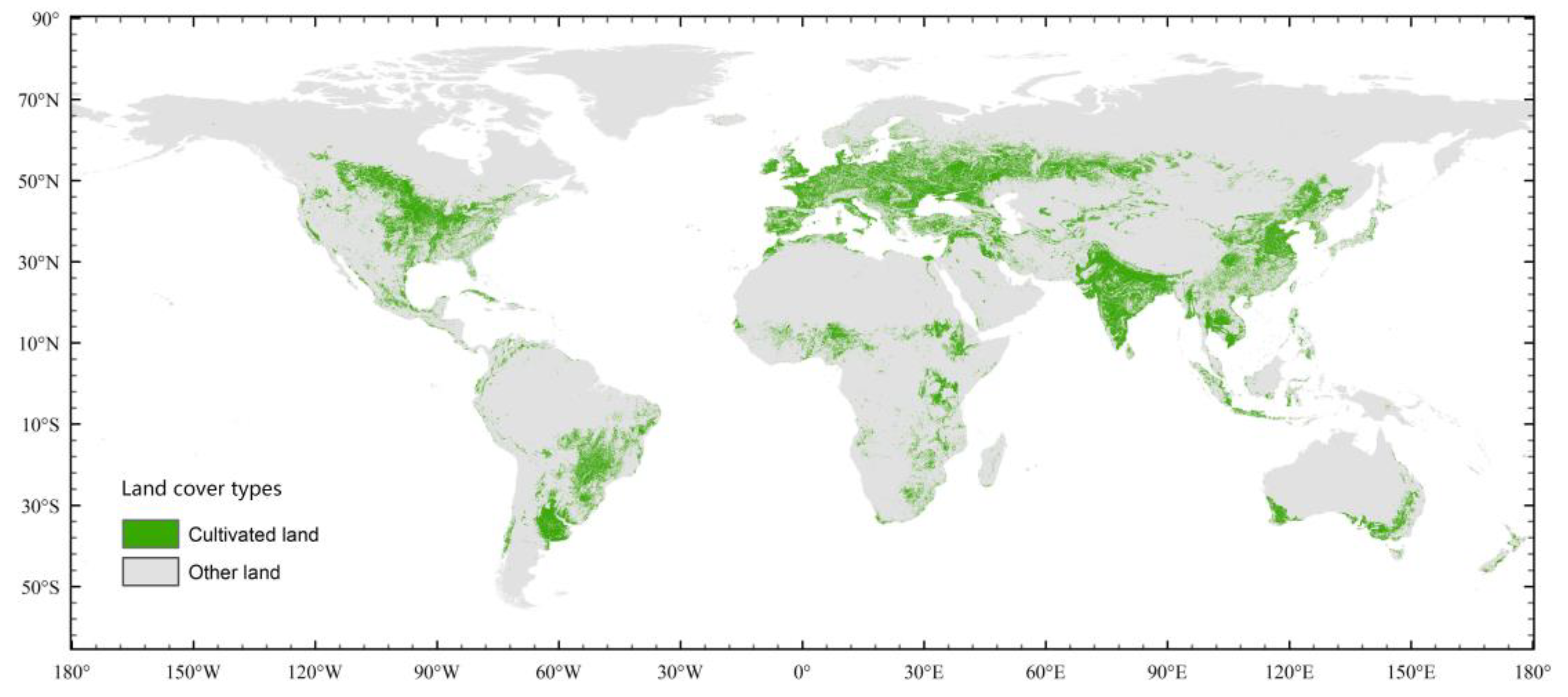
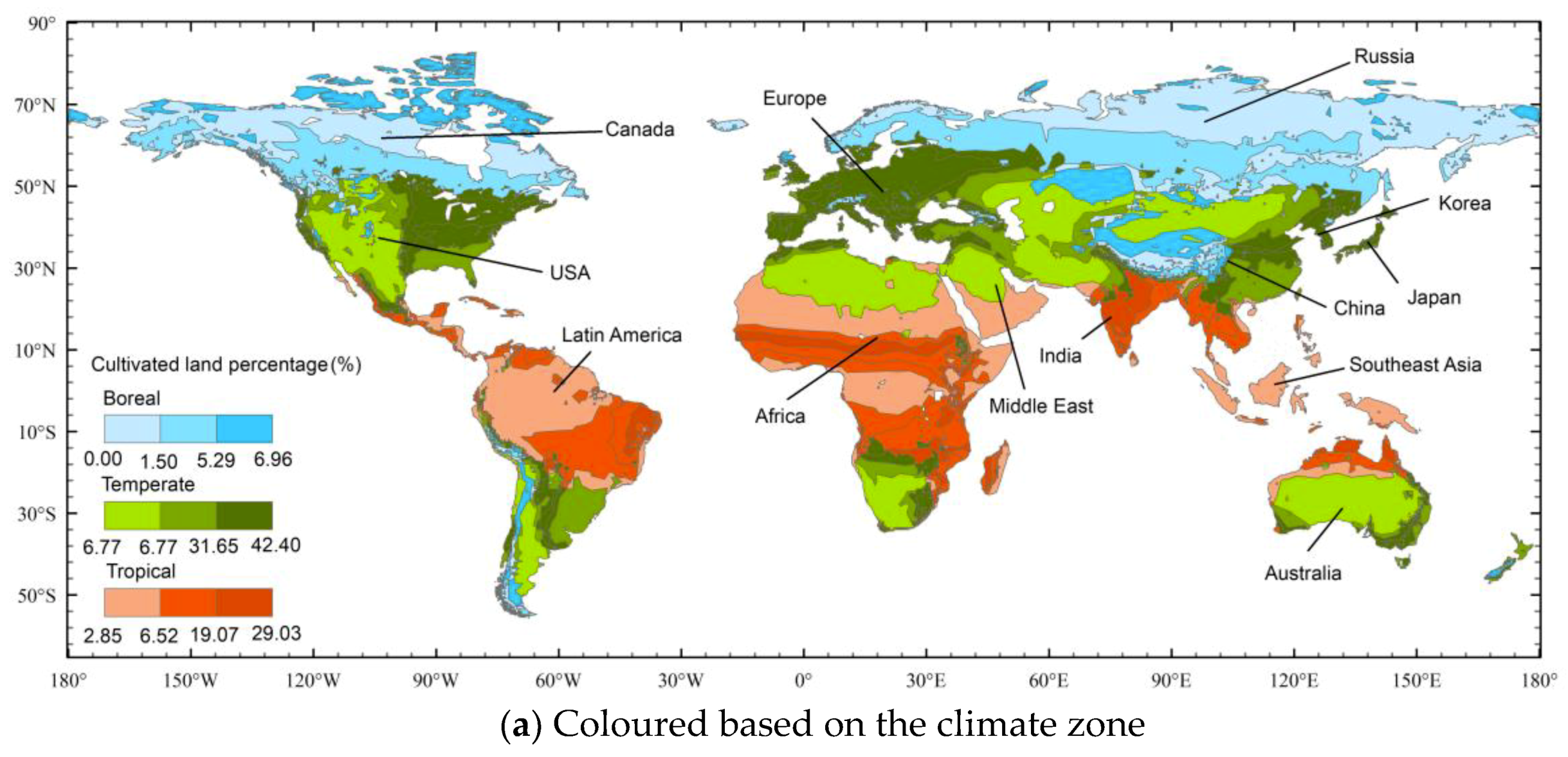
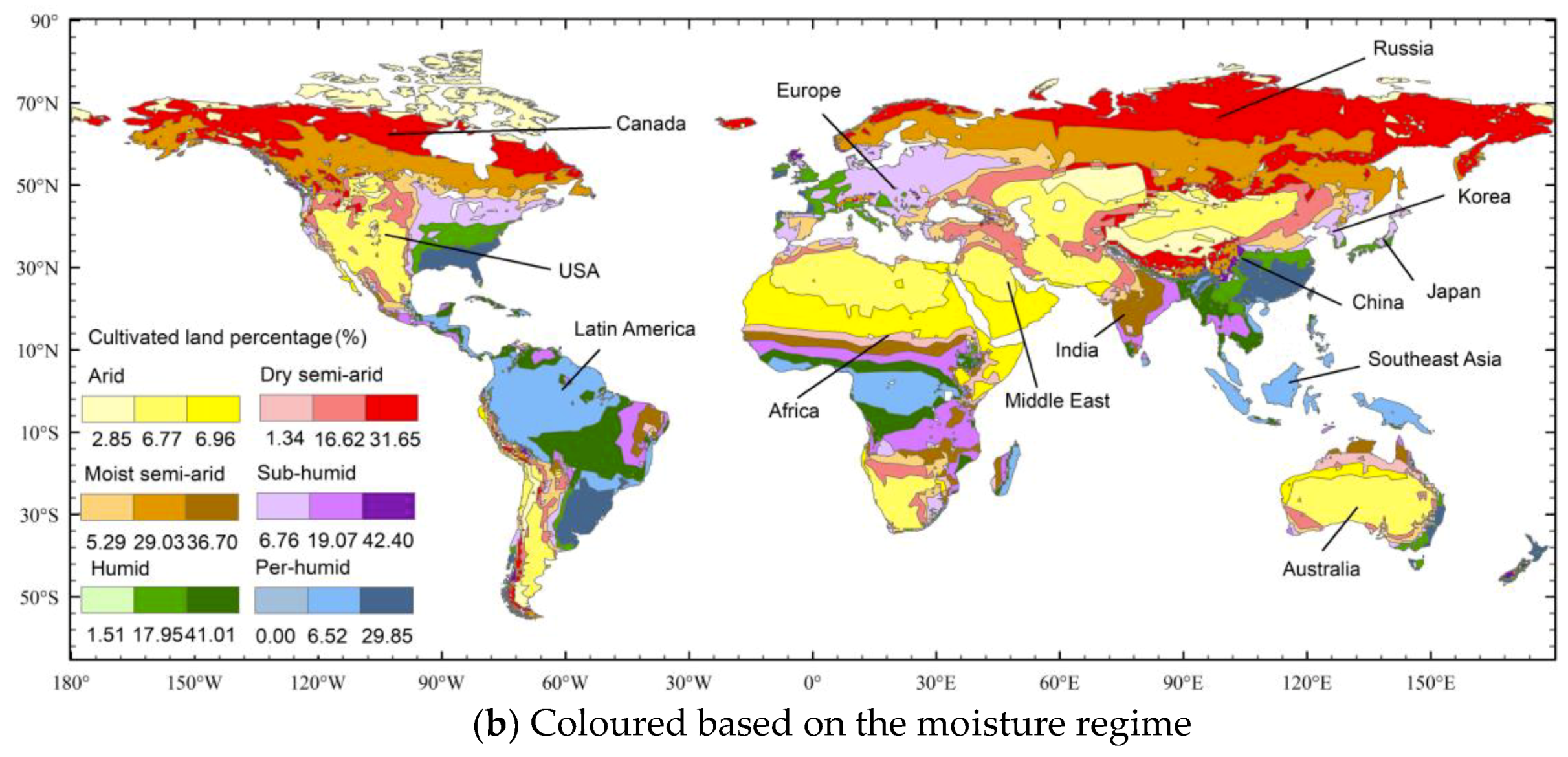
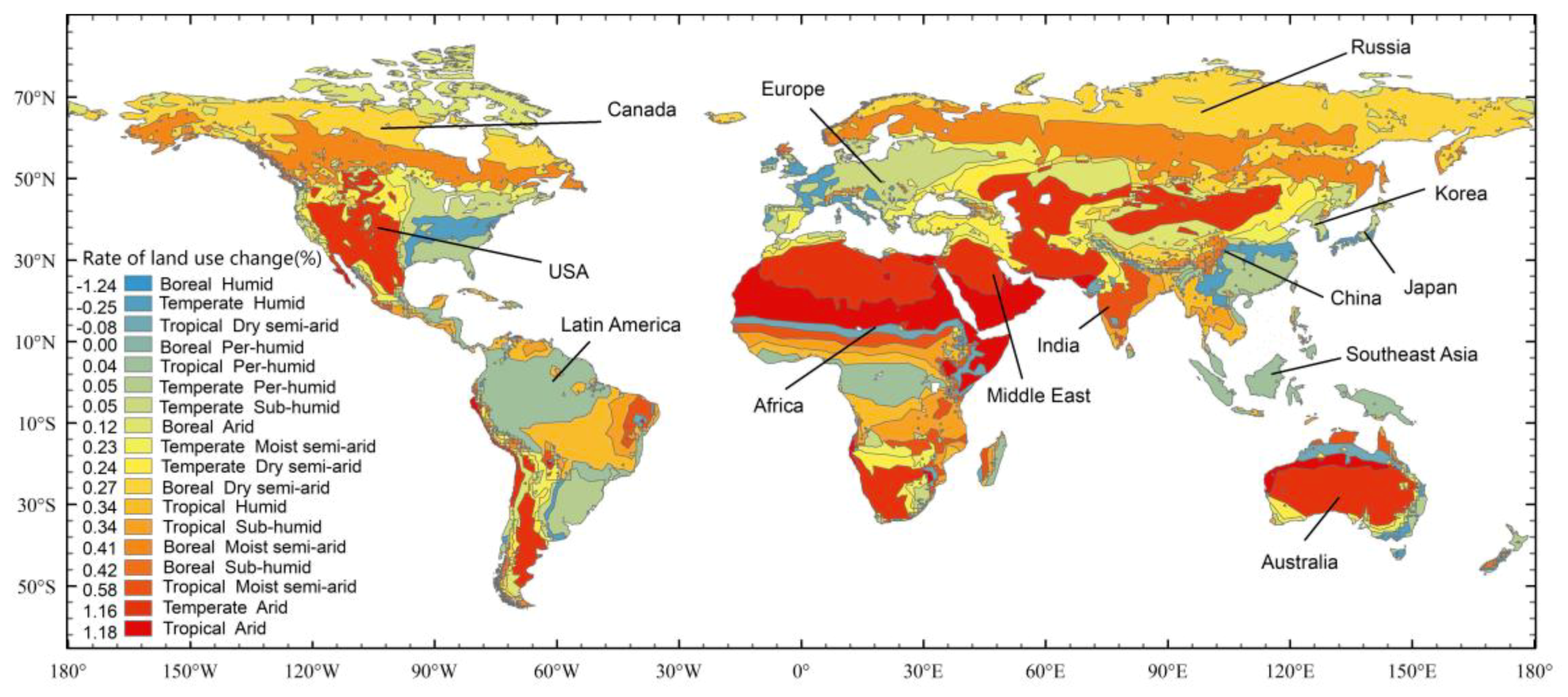


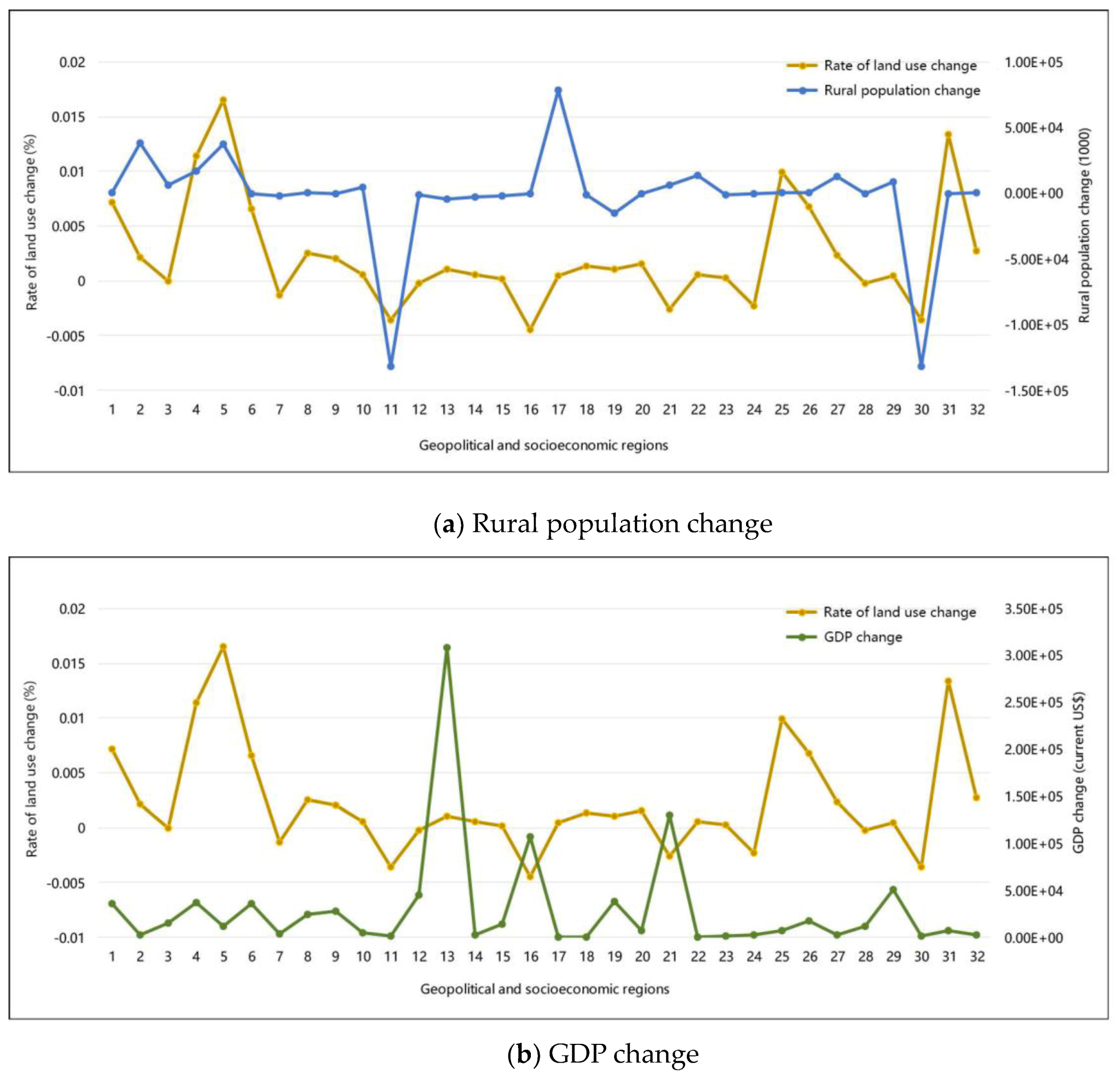

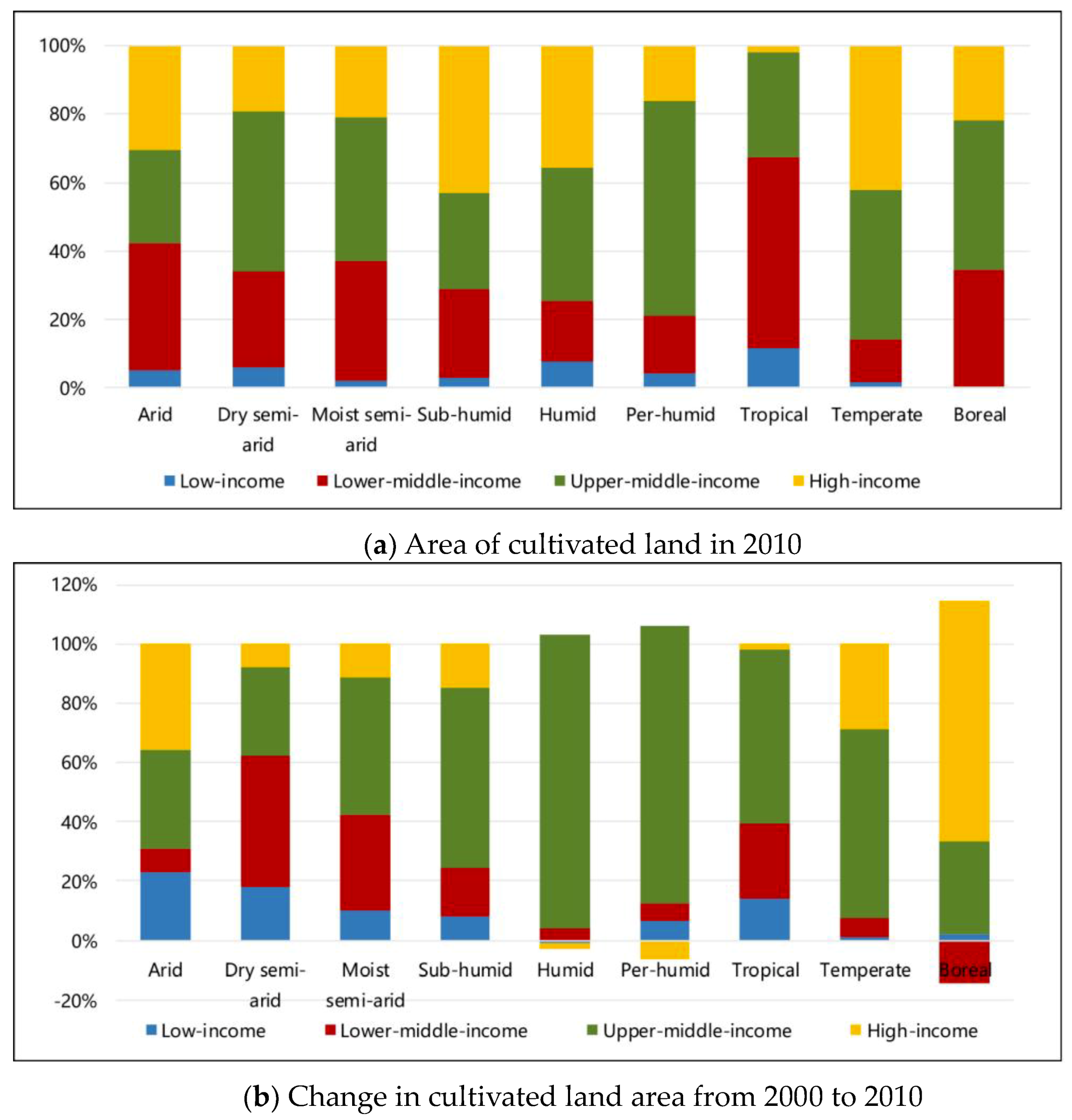
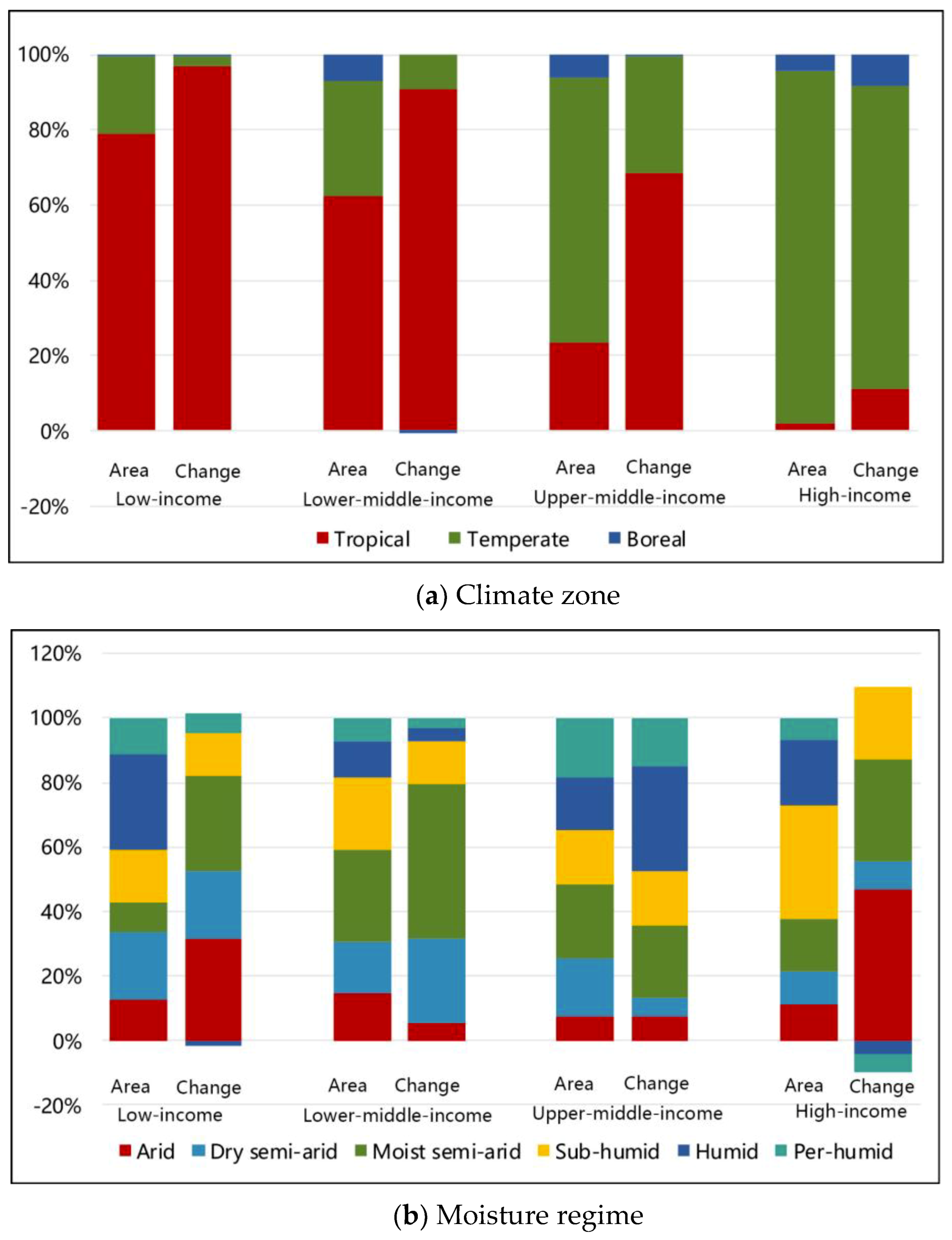
| 2000 | 2010 | 2010–2000 | |
|---|---|---|---|
| Area (106 km2) | 18.91 | 19.31 | 0.40 |
| Percentage (%) | 13.98 | 14.29 | 0.31 |
| Asia | Europe | North America | South America | Africa | Oceania | Global | |
|---|---|---|---|---|---|---|---|
| Percentage (%) | 36.31 | 22.21 | 14.63 | 12.12 | 11.70 | 3.03 | 100 |
| LGP in days | Moisture regime | Climate zones | AEZs | LGP in days | Moisture regime | Climate zones | AEZs |
|---|---|---|---|---|---|---|---|
| 0–59 | Arid | Tropical | AEZ1 | 180–239 | Sub-humid | Tropical | AEZ4 |
| Temperate | AEZ7 | Temperate | AEZ10 | ||||
| Boreal | AEZ13 | Boreal | AEZ16 | ||||
| 60–119 | Dry semi-arid | Tropical | AEZ2 | 240–299 | Humid | Tropical | AEZ5 |
| Temperate | AEZ8 | Temperate | AEZ11 | ||||
| Boreal | AEZ14 | Boreal | AEZ17 | ||||
| 120–179 | Moist semi-arid | Tropical | AEZ3 | >300 | Per-humid | Tropical | AEZ6 |
| Temperate | AEZ9 | Temperate | AEZ12 | ||||
| Boreal | AEZ15 | Boreal | AEZ18 |
© 2019 by the authors. Licensee MDPI, Basel, Switzerland. This article is an open access article distributed under the terms and conditions of the Creative Commons Attribution (CC BY) license (http://creativecommons.org/licenses/by/4.0/).
Share and Cite
Cao, M.; Zhu, Y.; Lü, G.; Chen, M.; Qiao, W. Spatial Distribution of Global Cultivated Land and Its Variation between 2000 and 2010, from Both Agro-Ecological and Geopolitical Perspectives. Sustainability 2019, 11, 1242. https://doi.org/10.3390/su11051242
Cao M, Zhu Y, Lü G, Chen M, Qiao W. Spatial Distribution of Global Cultivated Land and Its Variation between 2000 and 2010, from Both Agro-Ecological and Geopolitical Perspectives. Sustainability. 2019; 11(5):1242. https://doi.org/10.3390/su11051242
Chicago/Turabian StyleCao, Min, Yanhui Zhu, Guonian Lü, Min Chen, and Weifeng Qiao. 2019. "Spatial Distribution of Global Cultivated Land and Its Variation between 2000 and 2010, from Both Agro-Ecological and Geopolitical Perspectives" Sustainability 11, no. 5: 1242. https://doi.org/10.3390/su11051242
APA StyleCao, M., Zhu, Y., Lü, G., Chen, M., & Qiao, W. (2019). Spatial Distribution of Global Cultivated Land and Its Variation between 2000 and 2010, from Both Agro-Ecological and Geopolitical Perspectives. Sustainability, 11(5), 1242. https://doi.org/10.3390/su11051242





